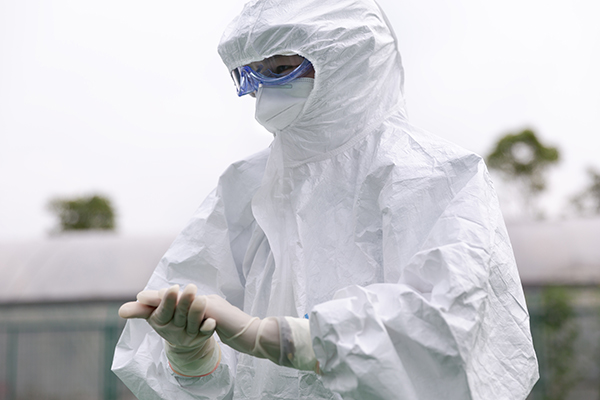“Navigating Pandemic Pathogens with Advanced Textiles: Insights into Clothing Hygiene, Antimicrobial Innovations, and Smart Wearable Tech“
Hey there, Textile Topher readers! Today, we’re diving into a topic that might have crossed your mind during the height of the pandemic: “Do I Need To Change My Clothes When I Get Home From The Grocery Store?” This question, inspired by a real query from the informed readership of LAist, could have most of us scratching our heads. As usual, our journey will connect the dots between everyday concerns and the fascinating world of textiles, with a sprinkling of tech consciousness.
The COVID-19 Context and Clothing Concerns
During the pandemic, many people were hyper-vigilant about hygiene—washing hands frequently, disinfecting surfaces, and maintaining social distance. But what about our clothes? Do we need to change our threads after a trip to the store? A listener named Ruth posed this exact question, and Dr. Robert Kim-Farley from UCLA’s Fielding School of Public Health provided a clear response.

Dr. Kim-Farley emphasized the importance of washing hands thoroughly—20 seconds, humming “Happy Birthday” twice. But what about fabrics? According to the good doctor, fabrics are unlikely to be significant vectors for the virus. The primary route of transmission is via droplets, and the virus tends to linger longer on hard surfaces like metal and plastic rather than on textiles. No need for wardrobe overhauls after each grocery run!
The Role of Technical Textiles During Pandemics
This leads us into the fascinating realm of technical textiles. Technical textiles, such as medical gowns, masks, and gloves, became the unsung heroes of pandemic-era apparel. These textiles are engineered for performance rather than aesthetics. For instance, nonwoven fabrics, typically made from polypropylene, are used in medical masks. This material has a high filtration efficiency combined with good breathability.
Speaking of materials, ever heard of
antimicrobial textiles**? These are textiles treated with agents that inhibit the growth of microorganisms. Imagine grocery shopping in an outfit that’s designed to kill or stop bacteria and viruses in their tracks! Though we might not have been changing our clothes multiple times a day, the possibility of antimicrobial clothing being part of our future wardrobes is quite thrilling.
How Are Smart Textiles Revolutionizing Hygiene?
Smart textiles, otherwise known as electronic textiles (e-textiles), offer a glimpse into a future where our clothes do more than just cover us—they interact with the environment, transmit data, and even respond to our health. Picture this: a fabric that can detect pathogens and alert you through an app on your phone. While this might sound like sci-fi, research in this area is making substantial strides.
In the scope of infection control, there are fascinating applications of
Photonic Textiles**. These textiles can emit light and may be integrated with UV LEDs. UV light is known for its disinfecting properties, capable of killing bacteria and viruses. Imagine your jacket emitting UV light to disinfect itself after a grocery run. These innovations could make concerns about virus-laden clothes a thing of the past.
Sustainable Practices Without Compromising Safety
The pandemic highlighted the colossal rise in the usage of single-use personal protective equipment (PPE), which has posed notable environmental problems. Herein lies an opportunity for sustainable technical textiles. Imagine materials that are both protective and biodegradable, offering safety without sacrificing sustainability.
Biodegradable polymers**, such as polylactic acid (PLA), are being researched for PPE production. PLA is derived from renewable resources like corn starch and sugar cane. Similarly, **nano-enhanced materials** hold promise. Nanosilver, for instance, is highly effective against pathogens; integrating such materials into textiles could provide long-term antimicrobial properties.
Home Hygiene: A Technological Perspective
As we circle back to Dr. Kim-Farley’s advice, it’s paramount to keep high-contact surfaces clean. However, can textiles help here too? Enter
Smart Cleaning Textiles**! For example, microfiber cloths, often used for cleaning, can be infused with antimicrobial properties. These can help in reducing microbial load on surfaces without the need for harsh chemicals.
Moreover, let’s not forget about
self-cleaning fabrics**. These textiles use advanced nano-coatings to repel water and stains, essentially cleaning themselves when exposed to sunlight due to their photocatalytic properties. Such textiles can reduce the frequency of laundry, lowering water and detergent usage, which is a win for both hygiene and the environment.
The Future of Fashion in a Post-Pandemic World
In light of Ruth’s question from LAist, it’s apparent that while immediate and drastic wardrobe changes might not be necessary, the pandemic has certainly nudged the textiles industry towards innovation.
Wearable technology** integrated with hygiene features might very well become a staple in our post-pandemic wardrobes.
Advanced textiles that integrate health monitoring features, capable of tracking heart rates, body temperature, and even detecting respiratory irregularities are already in development. Collaborations between textile engineers, health experts, and technologists are pushing the envelope of what we consider ‘clothing.’
Final Thoughts
So, do you need to change your clothes every time you get back from a grocery store? Dr. Kim-Farley suggests that it is not necessary, provided you practice good hand hygiene and are cautious about surface disinfection. However, this doesn’t mean the question isn’t valid. It serves as a catalyst for deeper conversations about the incredible potential of smart textiles.
In summary, the intersection of hygiene and textiles during the COVID-19 pandemic has spurred technological advancements and greater public interest in antimicrobial and smart fabrics. From technical textiles in medical gear to futuristic e-textiles that interact with our health, the landscape of clothing and hygiene is evolving.
Stay tuned, textile enthusiasts, as we continue to explore how the threads of our everyday lives are interwoven with tech innovations. Whether it’s through the lens of a pandemic or through futuristic garment technology, the textile world is always buzzing with excitement and endless possibilities. Until next time, stay fabric-fabulous!
Keywords: Smart textiles, Antimicrobial textiles, Technical textiles (Post number: 208), Hygiene, **COVID-19**





